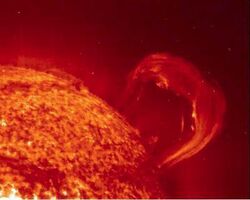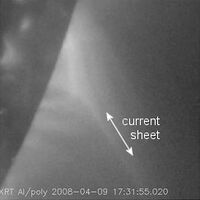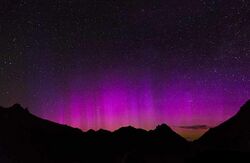Astronomy:Coronal cloud
| Coronal Cloud | |
|---|---|
 A coronal mass ejection, with the coronal cloud visible around it. | |
| Overview | |
| Name: | Coronal Cloud |
| Type: | Flare |
| Area: | Chromosphere |
| Statistics | |
| Average Size: | 66,000-240,000 Km |
| Temperature: | Same as Solar Flare |
| Occurrence Ratio: | About four Times Per Day |
| See also, CME | |
A coronal cloud is the cloud of hot plasma gas surrounding a coronal mass ejection. It is usually made up of protons and electrons. When a coronal mass ejection occurs at the Earth's Sun, it is the coronal cloud that usually reaches Earth and causes damage to electrical equipment and space satellites, not the ejection or flare itself. The damage is mostly the result of the high amount of electricity moving through the atmosphere.[1]
A coronal cloud is released when a solar flare becomes a coronal mass ejection; the coronal cloud often contains more radioactive particles than the mass ejection itself. A coronal mass ejection occurs when a solar flare becomes so hot that it snaps and breaks in two, becoming a "rope" of heat and magnetism that stretches between two sunspots. The resulting coronal mass ejection can be compared to a horseshoe magnet, the sunspots being the poles and the oscillating magnetic connector the handle. Coronal mass ejections typically do not last very long, because they cool down as the coronal cloud of gas is released and begins to hurtle away from the Sun.[2]
Formation and solar detachment

When a coronal cloud occurs, it can take several days for the plasma to grow cool enough to detach from the Sun. This usually happens before the coronal mass ejection is able to cool enough for the magnetism to dissipate, at which point the solar flare cycle begins again. While the gas cloud is still cool enough to be in a semi-liquid plasma state, it clings tightly to the mass ejection, insulating it from the cold temperature of extra-solar space.[3]
As the outer edges of the cloud begin to cool, the mass ejection's magnetic rope begins to cool, thereby decentralizing what remains of the flare by weakening its magnetic pull. After the cloud begins to cool, it gradually cools further and further into its core. The mass ejection expands into space as its insulating cloud weakens, weakening the magnet even more. By this point, the sunspots are all but gone.[4]
When the coronal cloud changes completely from gas to liquid, the cycle of detachment begins. The inner, liquid plasma area of the cloud is relatively small and being heated by the mass ejection, not the other way around. The mass ejection loses its magnetism almost immediately, and cools to gas form or falls back into the Sun within hours. However, the coronal cloud is still attached to it.[4]
The coronal cloud (no longer coronal) and what is left of the mass ejection detach from the Sun. The cloud of gas, radioactive particles, and electrons, however, is still in the Sun's gravitational pull. One of two things can happen:
- The cloud can be pulled back into the Sun, causing the cycle to restart.
- The cloud can detach from the Sun's orbit and begin hurtling out into space.
If the cloud begins hurtling into space, it usually becomes trapped in the planets' orbital gravity. By the time it gets to Earth, enough of the cloud has been absorbed by Mercury and Venus that the Earth's magnetosphere can deflect what's left into the outer Solar System. Occasionally, though, an abnormally large and fast cloud can pass a portion of its mass into the upper atmosphere.[5]
Effects
A magnetic cloud (as it is now termed) can travel toward Earth at speeds that can exceed 7,000,000 miles (11,000,000 km) per hour. On average, it usually takes them about 13½ hours to reach Earth. The cloud hurtling through space is called a solar wind. As many as five can be ejected from the Sun during solar maximum. When they reach the Earth, the large amounts of radioactive and electric energy can temporarily disrupt or even destroy electrical grids, antennae, communications devices, electric appliances, and near anything electric.[2] Minor damage may also be done to living organisms due to the low level radiation that gets through the magnetosphere.[2]
Specific reasons as to why these clouds are dangerous to electronic and communication equipment include the overloading of large power transformers, which can cause lengthy power outages over wide geographical areas. Long, metallic structures like oil and gas pipes, water pipes, and communications antennae can also carry excessive electric current from the air, causing them to corrode faster than normal. This can possibly lead to early, unexpected ruptures. These signals also create anomalies in the ionosphere, disrupting wireless technologies such as GPS, cellular phones, television, and radio.[2]
Notable occurrences



- September 1, 1859: English astronomers Richard Carrington and Richard Hodgson observed solar flares for the first time in recorded history, working independently and in ignorance of each other. We now know that one of the resulting coronal clouds was the largest and most powerful produced in historical times. The resulting electric storm was so powerful that the Aurora Borealis and Australis could both be seen far from the poles, extending to near the equator. Telegraph equipment users reported so much electric energy that their equipment delivered an electrical shock when touched as current flowed through the person inadvertently acting as a ground. Even after the devices were disconnected from their batteries, because telegraphs were simple switches to make or break the circuit between stations, that is, they contained no electronic components, like micro-circuitry to be destroyed, they could still be used to send messages, thanks to the electric current induced in the wires by the storm.[2]
- November 17, 1882: This cloud was first witnessed by two men, Dr. Brendel and Herr Raschen, in the Alten Fjörd, Lapland, Finland who came there to study auroras in January of that year.[6] It was nicknamed "The Transit of Venus Storm", and caused telegraph systems in the Ohio River valley region to cease to function, which incapacitated the Chicago Stock Exchange. On November 17, an aurora occurred, perhaps the most famous example of the phenomenon in history. This aurora's most prominent feature was a round beam of green light shaped like a cigar. It appeared in the eastern sky and crossed to the west at an extremely fast pace, faster than that of any known stars at the time, before disappearing. These events transpired less than a month prior to the 1882 transit of Venus, leading to the storm's nickname.[7]
- May 13–15, 1921: The most powerful coronal cloud of the 20th century passed through the Earth's atmosphere on May 13, and continued to take out electrical equipment as late as May 16. The most notable effect was that telegraph service was completely taken down around the world due to blown fuses, an extreme example was a New York City telegraph operator whose equipment caught fire and soon burned down the whole building at a cost of 6,000 1921 U.S. dollars. Furthermore, at 7:04 AM May 15, the New York City Subway system south of 125th Street was rendered non-functional by a massive control tower fire, another fire also took out the central Central New England Railway as well. Auroras were visible all over the world, and scientists at the time thought the Auroras directly caused the damage.[8]
- August 3–7, 1972: A series of flares and solar storms peaks with a flare estimated around X20 producing the fastest CME transit ever recorded and a severe geomagnetic and proton storm that disrupted terrestrial electrical and communications networks, as well as satellites (at least made permanently inoperative), and unintentionally detonated numerous U.S. Navy magnetic-influence sea mines in North Vietnam.[9]
- March 13, 1989: The second largest known solar storm erupted three days earlier, on March 10. The CME that caused the cloud was 36 times the size of Earth, and it had reached the Earth by March 12. The most notable effect of this storm is that it took the electrical grid off line in all of Quebec, Canada. Montreal , Toronto, and Quebec City were all without power, along with the rest of Quebec and some parts of Eastern Ontario that were hooked up to the same grid (including Toronto). The Canadian blackouts lasted for a total of nine hours, as much as a day in some Northern areas. Perhaps lesser known is that the blackout also affected much of the rest of North America. New York State's power grid lost 150 megawatts of power, New England lost 1,410 megawatts (96 utility companies reported lost power), and over 200 other power grids around the United States and Canada also lost power. The electrical disruption was so strong, that currents could be felt in the ground across the continent and several NASA satellites and ships, including TDRS-1 and Space Shuttle Discovery, spun out of control for several hours.[10][11][12]
- July 14, 2000: One of the strongest flares of the 1990s solar minimum, colloquially termed the "Bastille Day Event", was recorded on the morning of this day by NOAA satellites. The coronal cloud of protons and radioactive material took 15 minutes to reach Earth, at which point it had many adverse effects on magnetospheric satellites, most notably those owned by NASA. The storm was four times more intense than any other detected since 1995 by the SOHO and ACE solar monitoring systems by noon that day, and still intensifying. This particular event was causing aurora to appear very far South, in fact there was a red aurora photographed in North Carolina on April 6.[13]
- June 16, 2012: A major solar episode occurred during the third week of June 2012. From June 13 to 20, an abnormally large amount of Class-M solar flares and coronal mass ejections were emitted by the Sun in a relatively short period of time. No dangerous levels of radiation made it through the Earth's magnetosphere, therefore no damage was done to any surface-bound electronics or communications. However, minor damage was done to the Spitzer Space Telescope's electronics and some Mars exploration vehicles.[14]
- On July 23, a series of CMEs peaked with a storm considered to be a Carrington-class event, although the coronal cloud missed Earth.
See also
References
- ↑ Manfred Kaiser (2007). "Coronal Mass Ejection". Global BioWeather Inc. http://globalbioweather.com/coronal_mass_ejection.html. Retrieved 2013-02-19.
- ↑ 2.0 2.1 2.2 2.3 2.4 "Space Weather: Sunspots, Solar Flares & Coronal Mass Ejections". TechMediaNetwork. http://www.space.com/11506-space-weather-sunspots-solar-flares-coronal-mass-ejections.html. Retrieved 2013-02-19.
- ↑ Tony Philips (2008-05-27). "Cartwheel Coronal Mass Ejection". NASA. https://science.nasa.gov/science-news/science-at-nasa/2008/27may_cartwheelcme/. Retrieved 2013-02-09.
- ↑ 4.0 4.1 Lin Yong; S.F. Martin; O. Engvold (June 2006). ""Coronal Cloud" Prominences And Their Association With Coronal Mass Ejections". Aas/Solar Physics Division Meeting #37 (Institute of Theoretical Astrophysics, Norway) 37: 1.21. Bibcode: 2006SPD....37.0121L.
- ↑ Australian Space Academy (2000). "Coronal Mass Ejections". Australian Space Academy. http://www.spaceacademy.net.au/env/spwx/cme/cme.htm. Retrieved 2013-02-09.
- ↑ Alexander McAdie (October 1897). "What is a Aurora?". http://www.todayinsci.com/M/McAdie_Alexander/McAdieAurora.htm. Retrieved 2013-02-10.
- ↑ C. B. Henry (1882-11-17). "November 17, 1882 - The Transit of Venus Storm". The Kansas City Evening Star. http://www.solarstorms.org/SS1882.html. Retrieved 2013-02-10.
- ↑ "Low-latitude auroras: the magnetic storm of 14–15 May 1921". University of Nebraska Lincoln. 2001-01-01. http://digitalcommons.unl.edu/cgi/viewcontent.cgi?article=1003&context=usafresearch. Retrieved 2013-02-10.
- ↑ Knipp, Delores J.; B. J. Fraser; M. A. Shea; D. F. Smart (2018). "On the Little‐Known Consequences of the 4 August 1972 Ultra‐Fast Coronal Mass Ejecta: Facts, Commentary and Call to Action". Space Weather 16 (11): 1635–1643. doi:10.1029/2018SW002024. Bibcode: 2018SpWea..16.1635K.
- ↑ Adam Hadhazy (2009-03-13). "A Scary 13th: 20 Years Ago, Earth Was Blasted with a Massive Plume of Solar Plasma [Slide Show"]. The Scientific American. http://www.scientificamerican.com/article.cfm?id=geomagnetic-storm-march-13-1989-extreme-space-weather. Retrieved 2013-02-09.
- ↑ NASA (2003-10-23). "Solar Superstorm". NASA. https://science.nasa.gov/science-news/science-at-nasa/2003/23oct_superstorm/. Retrieved 2013-02-09.
- ↑ Sten Odenwald (2009-03-13). "The Day the Sun Brought Darkness". NASA. http://www.nasa.gov/topics/earth/features/sun_darkness.html. Retrieved 2013-02-09.
- ↑ Ruth Netting (2000-06-14). "A Solar Radiation Storm". NASA. https://science.nasa.gov/science-news/science-at-nasa/2000/ast14jul_2m/. Retrieved 2013-02-09.
- ↑ Lee Rannals (2012-06-15). "Incoming Coronal Mass Ejection Coming On June 16". redOrbit.com. http://www.redorbit.com/news/space/1112609310/incoming-coronal-mass-ejection-coming-on-june-16/. Retrieved 2013-02-09.
External links
- Coronal Mass Ejections: Scientists Unlock the Secrets of Exploding Plasma Clouds On the Sun, ScienceDaily.com
- A Scary 13th: 20 Years Ago, Earth Was Blasted with a Massive Plume of Solar Plasma, Scientific American
- A Strange Celestial Visitor
- The "Great" Magnetic Storms, 1875 to 1903

